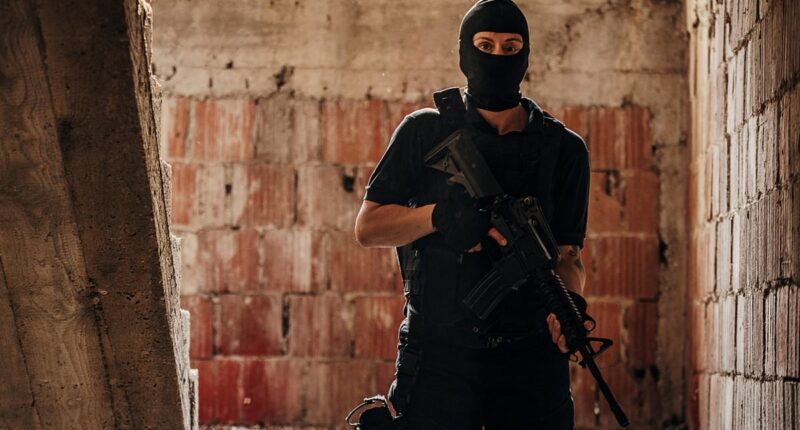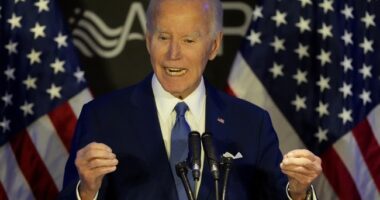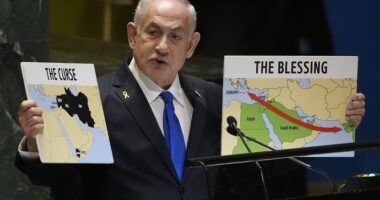An ex-FBI chief has cautioned that the United States remains exposed to a potential terrorist strike by pro-Iranian extremists who came into the country during the ‘open borders’ era under the Biden administration.
Chris Swecker, a former assistant director at the FBI during the 2000s, asserts that Hezbollah and other groups linked to Iran managed to infiltrate sleeper cells into the nation while the southern border was overwhelmed by migrants.
He pointed out that the danger could manifest in various forms — ranging from a lone attacker using a military-style rifle to carry out a mass shooting to large-scale attacks resembling those conducted by Hamas in southern Israel on October 7, 2023.
Crucially, Swecker warned that these operatives could strike in the US without any direct orders from Hezbollah’s headquarters in Lebanon or Iran, despite a ceasefire coming into effect.
‘I think there is a clear and present danger and the greatest terrorist threat in the post-9/11 era,’ Swecker told the Daily Mail.
He spoke after President Donald Trump announced a ceasefire between Iran and Israel, ending a 12-day war marked by unprecedented hostilities.
Israel launched its bombing campaign in a surprise attack on June 13, killing senior Iranian officials and destroying nuclear facilities. The US also targeted three nuclear sites on Sunday.
Tehran retaliated with waves of missiles that pierced Israel’s defenses in large numbers, saying that 610 people were killed and nearly 5,000 injured in Iran. Israel reported 28 deaths.

The US has been braced in recent days for an attack by a ‘sleeper cell’ of Middle Eastern commandos

Former FBI chief Chris Swecker says ‘religious fanatics’ could strike the US even without a green-light from Tehran
Swecker said the US must remain on alert despite the ceasefire because any sleeper cells or radicalized militants could strike even if an attack did not serve the interests of Iran or its proxies.
‘It’s not rational. There’s nothing to be gained by going out and killing Americans, shooting up a shopping mall or a sporting event, or driving a truck through a parade,’ Swecker said.
‘But they’re not rational. They’re religious fanatics, and they wouldn’t necessarily need a direct order from the mothership in Lebanon.’
Swecker said that Hezbollah, a political party-cum-militia in southern Lebanon, and other Iran-linked groups had for decades run fundraising operations across the US.
They likely slipped sleeper agents across the lax southern Border during president Joe Biden’s administration, he added.
As head of a prosecution effort in North Carolina in the early 2000s, Swecker said he had identified agents of the Shiite militia in Michigan, Kentucky and Canada.
He feared that more members entered came in among the ‘2 million gotaways’ who crossed the border undetected, or among the 1,000 Iranian nationals that Swecker said were let in under Biden’s watch.
‘It isn’t just the card-carrying memes of sleeper cells we have to be worried about. It’s the true believers who activate themselves,’ Swecker said.

Several agents likely snuck into the US amid the lax border security of the Biden administration

The US has not been this vulnerable since the 9/11 attacks, when terrorists launched the most devastating onslaught ever waged against the country

Iran spent decades arranging an Axis of Resistance to advance its revolutionary Islamist goals
‘One person with an AK-47 and a homemade bomb or just by driving a truck through a parade can take out a lot of people.’
Police in New York City and other metropolitan areas have in recent days stepped up patrols of religious, cultural and diplomatic sites amid warnings of a ‘heightened threat environment’.
New York City Mayor Eric Adams said ‘lone wolves’ were perhaps the biggest threat. Swecker and others pointed to Hezbollah agents or other armed Middle Eastern groups linked to Iran.
The Daily Mail takes a look at Iran’s Islamic Revolutionary Guard Corps (IRGC), its elite Al Quds Force for foreign missions, and the proxy groups it can direct and influence.
The Quds Force
Size: 20,000 (estimated)
Location: Iran, operates globally
Leader: In flux

Islamic Revolutionary Guard Corps armed personnel wear masks and participate in a military rally in downtown Tehran in January

Iran is reeling from devastating Israeli airstrikes, including June 23 hits on Islamic Revolutionary Guard Corps sites in Tehran
At the heart of Tehran’s global war machine is the Quds Force, the elite wing of the IRGC, tasked with foreign operations. It is named after the Arabic word for Jerusalem, and is likened to a spy agency with commando units.
With decades of experience funding, training and arming foreign fighters, the Quds Force is Tehran’s go-to instrument for asymmetric warfare. Analysts say that it is likely coordinating Iran’s response, selecting targets across the region and beyond.
The force built up a network of Arab allies known as the Axis of Resistance, establishing Hezbollah in Lebanon in 1982 and supporting the Palestinian militant Islamist group Hamas in the Gaza Strip.
Quds Force leaders have in recent years plotted to bomb Israeli and Saudi embassies in Washington, and been involved in assassination plots against Republican hawks John Bolton and Mike Pompeo, along with a Saudi ambassador to the US.
Intelligence chiefs fear that Quds Force already has ‘sleeper’ cells operating in the US homeland. Some 729 Iranian nationals were reportedly allowed into the US between 2021 and 2024, under the Biden administration’s relaxed border rules.
Still, the group has suffered devastating setbacks. Its leader, brigadier general Esmail Qaani, was reportedly killed in an Israeli strike on June 13. His infamous predecessor, Qassem Soleimani, died in a 2020 US drone strike.
Hamas
Size: 20,000 (estimated)
Location: Palestinian territories
Leader: In flux

Hamas fighters put on a show of force in January 2025, but it’s not clear whether they can stage a serious attack on Israel today
The Palestinian group Hamas was quick to condemn US strikes on Iran’s nuclear facilities, branding Washington and its regional ally Israel ‘fully responsible for the grave repercussions of this aggression’.
Yet while expressing ‘solidarity’ with Tehran in its official response, Hamas steered clear of that fight, saying it had ‘complete confidence in Iran’s ability to defend its sovereignty and the interests of its people’.
Hamas is not the force it was before the coordinated October 7, 2023, raids on southern Israel that prompted a ferocious reciprocal military onslaught on the militants and blameless Gaza residents alike.
Virtually all of Hamas’s senior leaders have been killed, and it remains unclear whether the group can still mount major attacks on Israel.
Israel says that it has killed some 20,000 militants in Gaza. US officials in January said Hamas had recruited as many as 15,000 fighters since the war began, though many were young and untrained.
Hamas is a Sunni militant group focused on a land dispute with Israel. It only ever had moderate ties with Shiite Iran. Hamas leaders expressed ‘disappointment’ at the lackluster support they received from Axis allies against Israel.
Hezbollah
Size: 50,000 (estimated)
Location: Southern Lebanon
Leader: Naim Qassem

Hezbollah fighters seen in 2002. The group has been torn apart by recent Israeli attacks
Hezbollah was once seen as the ‘crown jewel’ of Iran’s surrogates and the most deadly member of the ‘ring of fire’ to attack Israel in the event of war between the Jewish state and Iran.
But much has changed since Hamas’s October 2023 raids, and Israel’s military response in Gaza and then against Hezbollah in Lebanon, involving everything from airstrikes to exploding pagers.
The group is understood to be well short of the 100,000 fighters it boasted of in 2021. It bears the brunt of regular Israel strikes and commando raids, and has not launched a single attack on Israel since the recent flare-up began.
A spokesperson for Hezbollah told Newsweek that the group did not have immediate plans to retaliate against Israel and the US over their strikes on Iran’s nuclear program, saying Iran was a ‘strong country capable of defending itself’.
‘Logic dictates that it can confront America and Israel.’
Still, US intelligence agencies remain alarmed at Hezbollah’s worldwide footprint of terrorist cells, including militants who could have crossed America’s southern border to launch attacks on American soil.
The Houthis
Size: 10,000 to 30,000
Location: Yemen
Leader: Abdul-Malik Al Houthi

Yemen’s Houthi group followers are a wild card that could be the most likely to join Iran’s fight
The rebel Houthi armed movement in Yemen is the Tehran-aligned group perhaps best positioned to forcefully respond to the US and Israeli airstrikes on Iran.
Since the weekend attacks, the Houthis have vowed to support Iran in its fight and called for Muslim states to join the ‘Jihad and resistance option as one front against the Zionist-American arrogance’.
Yet while the Houthis have a track record of long-range drone strikes on Israel and missile attacks on shipping containers transiting the nearby Red Sea, these do not appear to have resumed amid the current escalation.
The Houthis are still technically bound by a ceasefire they struck with the US in May – Washington stopped its military campaign in exchange for the group halting attacks on US interests in the region.
The Houthis, too, have had their missile and other military assets in Yemen pounded by Israeli warplanes for months, along with US and British strikes aimed at reducing their threat to shipping in the region.
While the Houthis have received arms and training from Iran over the years, they follow a different branch of Islam, are geographically isolated and chiefly focused on their country’s 11-year civil war.
Syria and Iraq
Sizes: Various groups from 3,000 to 60,000
Location: Syria and Iraq
Leader: Various

Kata’ib Hezbollah members mourn the loss of one of their commanders in an Israeli antistrike in September 2024
In terms of raw manpower, Iran’s proxy strength is perhaps greatest across Iraq and, to a lesser extent, in Syria. Tehran has strong ties to nearly a dozen armed groups there, some with as many as 60,000 fighters.
Among the most formidable are Kata’ib Hezbollah, an Iraqi Shia Islamist paramilitary group founded in 2003 to fight off US-led forces there, and the Badr Organization, which was formed in the years after the 1979 Islamic Revolution.
Kata’ib Hezbollah has a record of attacking US bases at the behest of Iran. Its commander Abu Ali al-Askari has threatened to target US bases over its attack on Iran, telling CNN that they ‘will become akin to duck-hunting grounds’.
Still, these Shiite groups are also focused chiefly on local concerns. Iran in the past wielded great influence in Syria, thanks to President Bashar Al Assad’s growing reliance on Tehran to prop up his embattled government.
Tehran’s influence in Syria collapsed after Assad’s regime fell in December and Sunni rebels seized control of the country. Crucially, this denied Iran a land route to supply missiles to Hezbollah in Lebanon.
















